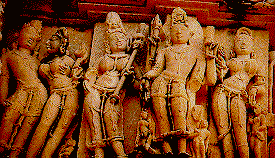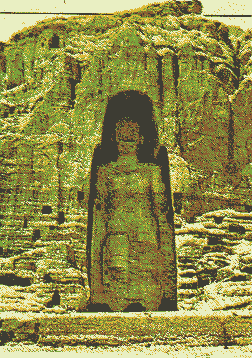|
Ancient India's Contribution to
Architecture And Civil Engineering
"The Indian way of life provides the vision of the natural, real way of life. We veil ourselves with unnatural masks. On the face of India are the tender expressions which carry the mark of the Creators hand. "
- George Bernard Shaw, Famous British Author
The Science of Architecture and Civil Construction was known in Ancient India as Sthapatya-Shastra. The word Sthapatya is derived from the root word Sthapana i.e. 'to establish'. The technique of arhitecture was both a science and an art, hence it is also known as Sthapatya-kala, the word Kala means an art.
 Panel at Khajuraho created in the 10th century in Madhya Pradesh in Central India.
Panel at Khajuraho created in the 10th century in Madhya Pradesh in Central India.
From very early times the construction of temples, palaces, rest houses and other civil construction was undertaken by professional architects known as Sthapati. Even during the Vedic times, there exIsted professionals who specialised in the technique of constructing chariots and other heavy instruments of war. These professionals have been referred to in the Rig Veda as Rathakara which literally means 'chariot maker'.
The excavations of the ruins at Mohenjodaro and Harrappa (today in Pakistan) proved the existence of a developed Urban civilisation in India. The indus valley civilization is dated around 3000 B.C. Thus since the last 5000 years. India has had an urban civilisation. The existence of an urban civilization presumes the existence of well devel oped techniques of architecture and construction.
These techniques would no doubt have had been systematically stated in record books for transmitting them to the later generations as well for being used as reference media for actual construction. Unfortunately, as far as the Indus Valley civilization goes no such records have been preserved either as rock edicts, manuscripts, etc., or in folk tales and legends.
 But the fact that cities on the scale of Mohenjodaro had been constructed bear testimony to the existence of a systematised and highly developed technique of architecture 5000 years ago.
But the fact that cities on the scale of Mohenjodaro had been constructed bear testimony to the existence of a systematised and highly developed technique of architecture 5000 years ago.
Boddhisattvas (huge Buddha Statues) at Bamiyan in Afghanistan These statues were carved out of this hillside in the 1st Century under the patronage of the Kushana emperor Kanishka (These are the statues which the Taliban has vowed to blow up).
But in the later ages, from about the 7th century B.C., we have both literature references as well as archeological evidences to prove the existence of large urban civilizations in the Ganges Valley. Like in most other sciences, even remotely connected with religion, in architecture also the scientific ideas and techniques have been integrated with philosophy and theology. This was so as the majority of the large constructions were temples. As the construction of Hindu temples rarely used mortar but used a technique where the stones could be affixed to one another with the force of gravity. The technique followed in doing this was similar to the one used in the Roman Aquaducts. The exquisite carvings were engraved after the stones had been fixed in their places. Thus the carving of figurines right upto the top of a temples roof must have been a demanding task.
|